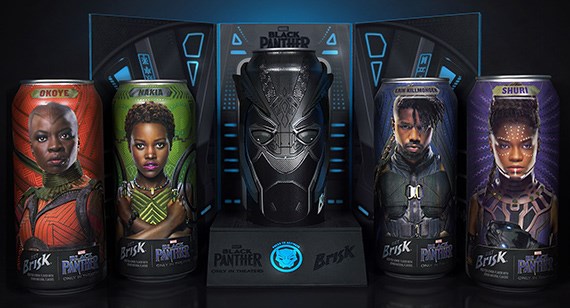Black Panther and 3D Printing: PepsiCo Reveals Details About This Year’s Promotional Campaign
Marvel’s Black Panther was a huge hit earlier this year, and 3D printing played a starring role through the costume design. In addition, PepsiCo took advantage of the technology to have a limited edition series of Black Panther cans created, as seen at RAPID + TCT in May. Now the company has released more details on the process that went into making the cans, which featured a 3D printed mask created by Protolabs.
The special cans, which featured the movie’s main characters, were part of a promotional kit that also contained a Samsung tablet, comic books, behind the scenes photos, a light-up carton with smart LEDs, and, of course, the 3D printed Black Panther mask that fit onto the can.
“Much of this kit was inspired by the costumes and characters from the movie,” said Andrew Phinney, R&D packaging engineer at PepsiCo. “This was an exciting opportunity for us to incorporate new technologies to develop unique textures, graphics, dimensional elements, and lighting to bring the kit to life.”
Phinney led the mask’s technical development, and he and his team were faced with the challenge of producing a complex shape economically at a low volume, since they were only going to be making 250 of the promotional kits.
“Given the detailed features on the mask and the relatively low volumes of parts, we knew early on that 3D printing was going to be the most suitable manufacturing process for this project,” Phinney said. “The volumes were not high enough to justify investing in an injection molding tool and we liked the design freedom that 3D printing provides.”
For early stage prototypes, in-house FDM 3D printers were used to alter the design of the original mask so that it aligned with the design on the can and fit securely on it. The team then began considering what 3D printing technique to use for later prototypes and ultimately production. They decided to try out CLIP, SLS and Multi Jet Fusion technologies, and eventually settled on Multi Jet Fusion thanks to its low cost, high resolution, and excellent surface finish.
“When we received the Multi Jet Fusion part it was clear that this technology was going to meet the cosmetic requirements we outlined at the beginning of the design process,” said Phinney. “Not only did the part look great, but it was also the most affordable process among the final three technologies we considered. Since the can was meant to be a collector’s item, we wanted a part that could last 10 to 20 years. While other processes like SLA and PolyJet have high resolution, there was no guarantee that they would hold the deep black color and be able to last for several years.”
The final parts were 3D printed by Protolabs and put through a series of compression, vibration and drop tests, which they passed, remaining securely on the can. Just before the Black Panther premiere, the promotional kit was finished and sent out to hundreds of online influences and others involved with the movie. According to Phinney, it took less than six months to conceptualize, engineer and produce the kit.
“We needed a supplier that could meet our deadlines and Protolabs provided us with quality 3D-printed parts on time throughout the project,” said Phinney. “The success of the Black Panther mask not only demonstrates Protolabs’ capabilities, but the potential of 3D printing to advance packaging design.”
Discuss this and other 3D printing topics at 3DPrintBoard.com or share your thoughts below.
[Source: Plastics Today]
Subscribe to Our Email Newsletter
Stay up-to-date on all the latest news from the 3D printing industry and receive information and offers from third party vendors.
Print Services
You May Also Like
RAPID 2025: Stratasys & trinckle Announce Strategic Software Partnership
News continues to flood in from last week’s RAPID+TCT 2025, including a new partnership between AM market leader Stratasys and Berlin-based software company trinckle. By automating important steps in fixture...
RAPID TCT 2025: Spring in the Paris of the Midwest
I’m going to go out on a limb here and say that whomever coined the phrase Detroit: Paris of the Midwest, had not spent a lot of time in Paris...
3D Printing Financials: 3D Systems Looks to Bounce Back in 2025
After a challenging year for the industry, 3D Systems (NYSE: DDD) ended 2024 with results pointing to a reset, laying the groundwork for future profitability. The company didn’t post strong...
Printing Money Episode 27: Q4 2024 Public 3D Printing Earnings Review with Troy Jensen, Cantor Fitzgerald
Q2 2025 has already begun, but public markets reporting has only just finished with Q4 2024. To tie a bow on Q4 2024, we are thankful to have Troy Jensen...




























